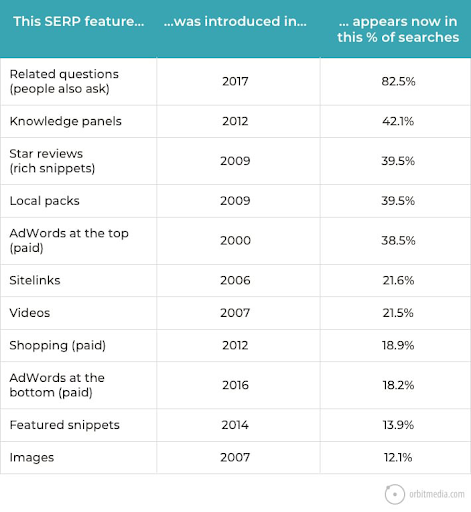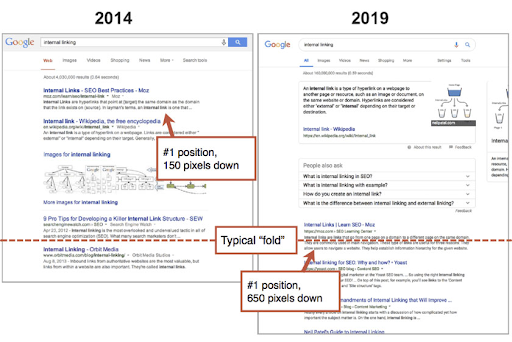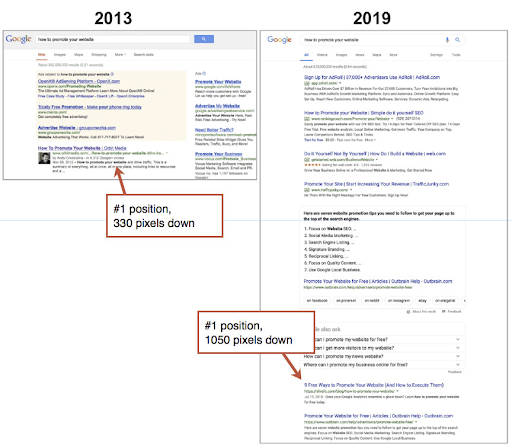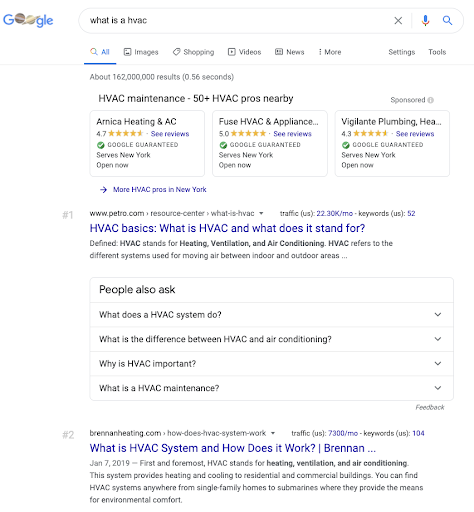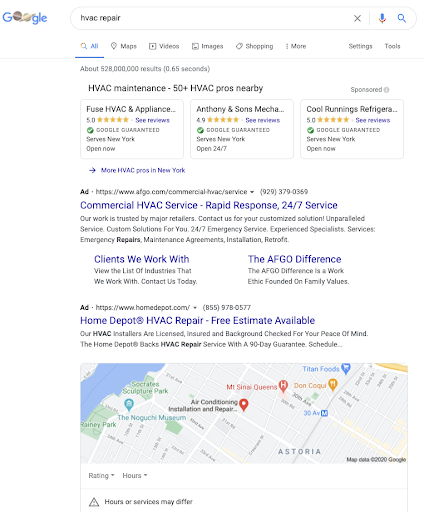Search Engine Result Pages (SERPs) are report cards all SEOs grade their strategies by, but what do you do when that report card keeps changing? As SEOs, we understand our industry is in a state of flux all the time. All our work is based on the constantly evolving algorithms and SERP layouts of different search engines like Google, Bing, Yahoo, etc. and it’s our job as SEOs to ensure we stay on top of the ever-changing landscape (both figuratively and literally when it comes to SERPs).
To fully understand why changing SERPs are imperative to a winning SEO strategy, let’s briefly compare Google’s first SERP in 1998 to today’s:
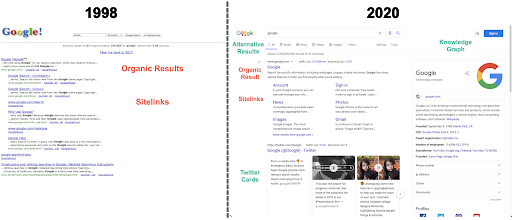
Source : Towermarketing.net
The differences are quite stark. The SERP from 1998 only shows organic results and sitelinks while the SERP from 2020 shows organic results and sitelinks as well as alternative results like Books, News, Videos, Images, etc., Twitter Cards, and a Knowledge Graph. Those are a lot of changes, and we’ve just scratched the surface.
The reason for the evolution of SERPs is that Google wants to increase the amount advertisers spend on their Ad platform. In order to prove the ROI, Google also needs to have strong user engagement. The best way to have strong user engagement is to provide the best user experience possible.
What is a SERP?
If you’re reading this article, you most likely already know what a SERP is, but for those less familiar with SEO, a SERP is a search engine results page or the page that a search engine shows to users when they search for something online using a search engine like Google, Yahoo, Bing, and others.
SERPs are incredibly important because it is ultimately where SEO battles are won or lost. As I mentioned at the beginning of the article, it is a constant indicator of how well your SEO strategy is working.
There are many components of a SERP, some of which we will go over below, but for more information around SERPs in general, here’s a great guide from Search Engine Journal.
Constantly Changing SERPs
Today, no two SERPs are the same, even if you are searching for the same keyword. Instead, they are personalized for each user. This explains why you sometimes see different search results when searching on different devices or from new locations, but there are a number of other reasons why SERPs are constantly different. Before we dive into them, the two biggest categories for changing SERPs are:
- Google’s Evolution
As I mentioned above, Google is constantly evolving to better meet the needs of users in both content (via their algorithm → better results returned) and form (via their SERP → improved user experience based on SERP layout). - User Intent
Building off of Google’s evolution, to provide the best user experience, Google must first improve discerning a user’s intent. Several factors go into user intent like location, user journey, etc. and one way Google has tried to answer a user’s intent is by adding features to the SERP to improve a user’s experience.
For example in the below table, Featured Snippets, introduced in 2014 now appear in almost 14% of searches, provide users with an answer to their search immediately in the SERP without needing to choose and click through to a site ranked on the SERP. For users, this is one less step to have their question answered, therefore improving their user experience.

SERP features have become so prominent that Google sometimes will use multiple features. Here’s an example of the same keyword searched in 2014 and 2019, with two totally different SERPs. 2014 only has one SERP feature – a section for image results under the 2nd organic result. 2019, however, has at least two SERP features, a Featured Snippet, as well as People Also Ask section.

Source: Torquemag.io
Other factors below can really be grouped into either of the major factors above, but are important enough to call out individually: - PPC’s Real Estate Expansion (subfactor of Google’s Evolution)
Google continues to increase the amount of space above the fold of the SERP (before a user needs to scroll down the page) for PPC ads to increase its ad revenue. See below how PPC ads from 2013 compared to 2019 have not only increased in number (from 3 to 4) but have also taken up considerably more room on the SERP pushing organic results down below the fold.

Source: Torquemag.io - Location (subfactor of User Intent)
SERPs vary depending on your location. As you can imagine, a user searching for “food near me” in New York City will see a very different SERP than if they were searching in San Francisco. - User journey (subfactor of User Intent)
User journey refers to where a searcher is in the sales funnel, e.g. are they at the top of the funnel in the awareness stage of their purchase journey or at the bottom of the funnel in the conversion stage at the end of their purchase journey? Determining the answer to that will affect your SEO strategy to capture your target business keywords that fall into either category.
A user at the top of the sales funnel, in the awareness stage of their purchase journey, will most likely see a SERP with information based features and results. Below is an example of someone at the beginning of their purchase journey, searching to understand “what is a hvac”:

As you can see above, PPC ads are visible, but take up little room at the top of the SERP, organic results are still above the fold, and there is a People Also Ask section that answers common questions around this topic.
On the other hand, a user at the bottom of the funnel, in the conversion stage, will see a SERP with features and results geared more towards taking action, e.g. Ads taking up the top of fold, Local Pack to show businesses that offer the service users are looking for, etc., which is what we get when we search for a keyword with conversion intent like “hvac repair”:

- Same keyword, different intents (subfactor of User Intent)
If a user searches for “jaguar(s)”, Google will take its best guess as to what the searcher is looking for. Whether it’s the car marker, the American football team, or the animal, Google’s SERP will reflect what it believes to be the intent of the user.


- Seasonality (subfactor of User Intent), which we will get into in more detail below.
Regardless of what the SERP looks like or what features and the result it returns, it gives marketers insight into the user experience Google is trying to create. SERP layout shifts also tell us a lot about what Google is focusing on and therefore what we as SEOs should be focusing on. Ultimately, SERP layout shifts help marketers understand Google’s focus and predict the future of SEO.
What is seasonality?
A broad definition of seasonality is when data experiences regular and predictable changes that recur every calendar year. Any predictable fluctuation or pattern that recurs or repeats over a one-year period is called seasonal. In other words, when you see a recurring pattern in your data that happens every year at the same time. Now take this logic and apply it to your SEO data.
How do you spot this pattern? There are several ways, but the two most common are, looking at your traffic or looking at your target business keywords.
Traffic seasonality:

This is a great example of a site capitalizing on their seasonality. Each consecutive year, the traffic around the week of Valentine’s Day grows year over year. Clearly, this site understood the opportunity seasonality presented and ensured their site was well optimized to capture that increase in interest and saw the results in increased traffic year over year.
Keyword seasonality:
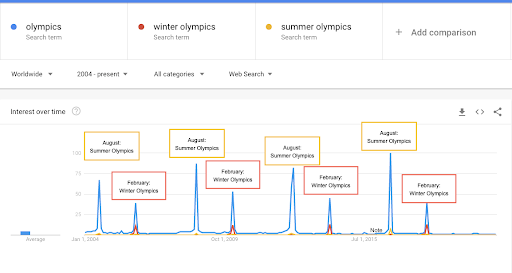
Google Trends
Using tools like Google Trends (above) to understand keyword seasonality is key to uncovering major SEO opportunities. From the above, there are three insights that stand out:
- There are large spikes of seasonality for the keyword “olympics” independent of whether it is the Winter or Summer Olympics
- “winter olympics” and “summer olympics” also see seasonal interest, but much less than the broad “olympics” keyword and only during their respective seasons.
- All three keywords experience seasonality, but interest varies greatly, the broad keyword “olympics” dominating the other two keywords
From these insights, we might conclude that, despite the season, most users will search for “olympics” and rely on Google to serve them the most relevant results based on the time of year they are searching. This ties back to user intent changing the SERP because Google understands a user searching for “olympics” in July or August is looking for information about the Summer Olympics as opposed to the Winter Olympics. Now, we can put together an SEO strategy that takes these insights into consideration.
Often you will get a sense of a site’s or business’ seasonality by using common sense (i.e. the Olympics only come around once every few years and is a major global event). But if it’s not obvious, check your analytics & Google Trends to see if you can uncover any seasonality potential.
How does seasonality affect SERPs?
Now that we’ve discussed numerous ways in which SERPs can change, let’s deep dive into how seasonality affects SERPs.
First, let’s pick “winter coats” as our target business keyword to dive into. Logic tells us that peak seasonality for this keyword would be in the winter, and off-peak seasonality would be in the summer.
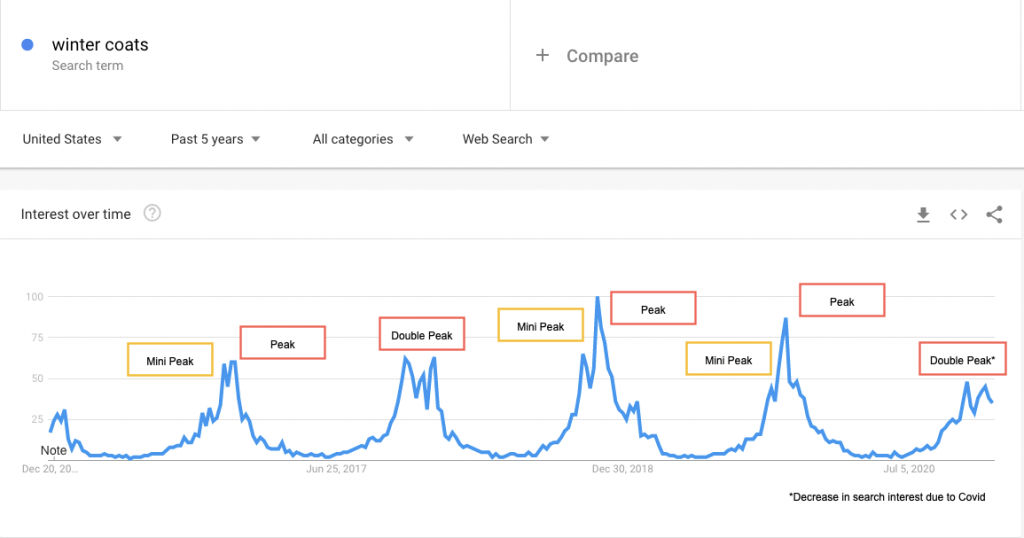
Google Trends
Verifying our logic using Google Trends shows that we are correct. Now let’s compare the SERPs to see how different they are during peak and off-peak seasons.
We can do this by comparing historical SERPs using SEMRush. In the Keyword Overview tab, we can select the month and year we want to view (boxed in red below), and there is a section (highlighted yellow below) that details what the SERP for that keyword looked like during the time period selected.
First, let’s look at the peak of seasonality for this keyword in November:
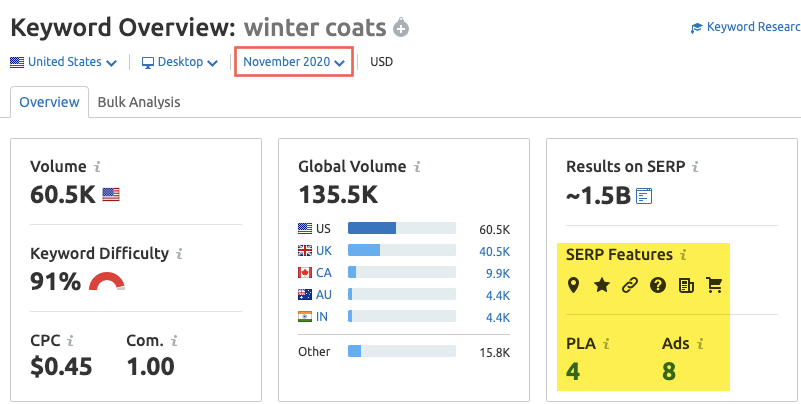
SEMRush
During peak season (November), the SERP for “winter coats” includes:
- 8 PPC ads (top)
- 10 Product listing ads
- Local Map pack
- Ratings & Reviews
- Site links
- FAQs
- Top stories
- Shopping ads
Taking a look at that list, you might be wondering how can there be room for the organic listings?! Which is a very good question. Let’s take a look at the SERP during off-peak season before we answer that question.
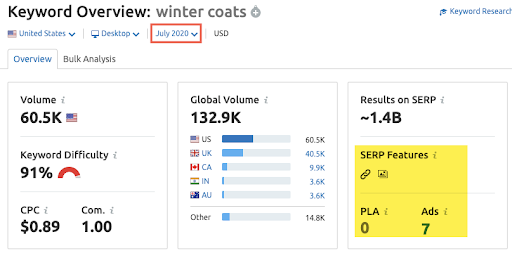
SEMRush
During off-peak season (July), the SERP for “winter coats” includes:
- 7 PPC ads (top)
- Sitelinks
- Image pack
It may not be a surprise that in the off-peak season, the SERP for “winter coats” feels almost bare compared to what the SERP looks like during peak season. This indicates that the competition during peak season is two-fold: first, standard competition for organic rankings on page 1 and second, capturing as many relevant SERP features as possible. So even if a site is ranking well organically, with all of the SERP features drawing the eyes of the user, standing out on the SERP is more important than ever.
Now let’s look at a lifestyle example to see if we find the same pattern that we did with e-commerce. For “how to lose weight”, here are the peak and off-peaks seasons:
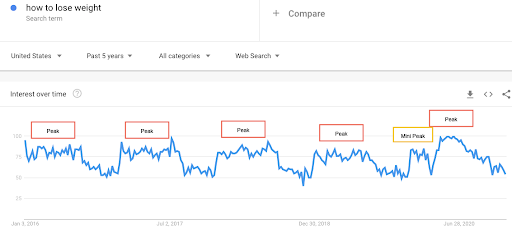
Google Trends
One noticeable difference between this example and the “winter coats” example is that the peak season for “how to lose weight” is much longer. It’s more of a plateau than a peak.
As before, we will now look at the SERPs to understand how they change between peak and off-peak season so we can formulate an SEO strategy.
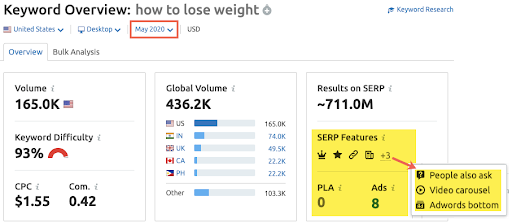
SEMRush
During peak season, the SERP for “how to lose weight” includes:
- 8 PPC ads (top)
- Featured snippet
- Ratings / Reviews
- Site links
- Top stories
- People Also Ask
- Video Carousel
- PPC ads (bottom)
Similar to what we saw for the “winter coats” SERP during its peak season, this SERP is full of features in addition to the normal organic listings.
Now let’s look at the “how to lose weight” off-season SERP:
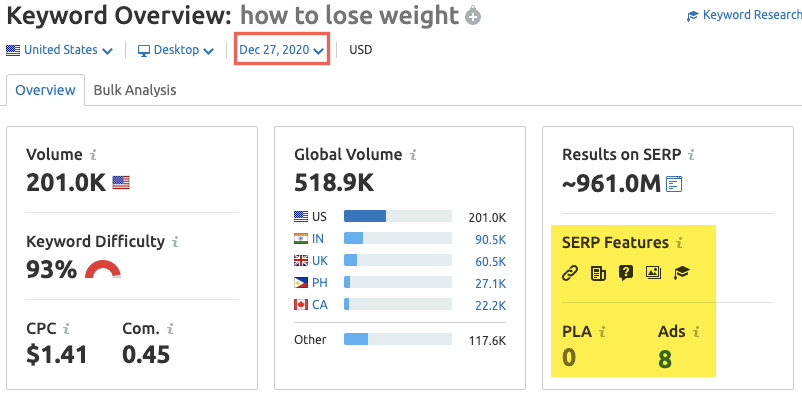
SEMRush
During off-peak season, the SERP for “how to lose weight” includes:
- 8 PPC ads (top)
- Site links
- Top stories
- People Also Ask
- Image Pack
- Knowledge Panel
While this off-peak SERP is less bare than “winter coats”’s SERP, there are still less features. During off-peak season, there is less competition from Paid search (there are no longer ads at the bottom of the SERP). Featured snippets, Ratings / Reviews, and the Video Carousel are also missing, meaning there is more room for normal organic listings to appear on the SERP.
By looking at these two different examples of seasonality and how SERPs can be affected, one thing becomes clear. During peak season, Google’s SERP is loaded with enhanced SERP features as well as PPC ads designed to help the user convert as quickly as possible. During off-peak season, there is less intention of converting (whether monetarily or via lead generation), which is reflected in the SERPs.
How to make sure your SEO is going with the flow
Now that we 1. know what a SERP is 2. understand how and why SERPs are ever-changing 3. understand what seasonality is and 4. understand how seasonality affects SERPs, let’s put all of that together to understand how we can capitalize and optimize for SERP seasonality.
Let’s look at another e-commerce example to understand how we can optimize for SERP seasonality.
As mentioned above, first we need to either understand the periods of seasonality from our site analytics or we use a tool like Google Trends to find out the seasonality of our target business keywords. For this example, we are looking at the keyword “swimsuits” with an average of 368,000 searches per month.
You can get more granular search volume data with tools like Clearscope, which break down the search volume per month. As you can see, June is the peak of seasonality for “swimsuits”, interest started to mount in February, with a lift in May before the peak in June.

Clearscope.io
This data is confirmed by Google Trends over the past five years and even shows weekly data:
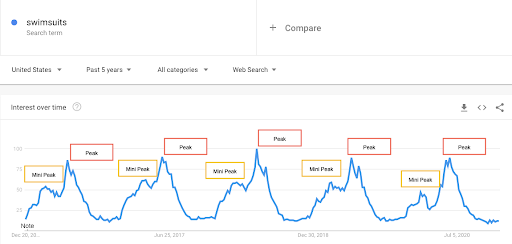
Google Trends
The insight we gain from these two sources is pretty impactful. Instead of coming away with one golden nugget of opportunity, we now have two! A mini peak in March (for spring vacation we can presume) and the major peak in June (start of summer). Now, marketers have a better understanding of when they should begin to optimize their site for “swimsuits” and what they can expect.
Now that we’ve identified the seasonality for our target business keyword, the question is “how do we optimize for it?” and as we’ve discussed above, the answer lies in the “swimsuits” SERP.
First, let’s take a look at the peak season SERP:
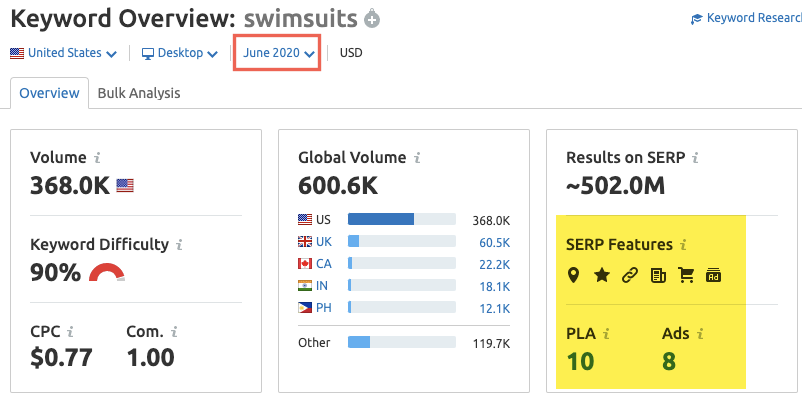
SEMRush
During peak season (June), the SERP for “swimsuits” includes:
- 8 PPC ads (top)
- 10 Product listing ads
- Local Map pack
- Ratings / Reviews
- Sitelinks
- Top stories
- Shopping ads
- PPC ads (bottom)
Similar to what we saw for the “winter coats” and “how to lose weight” SERPs during their peak season, this SERP is full of features in addition to the normal organic listings.
Now let’s compare to the above to the “swimsuits” off-season SERP:
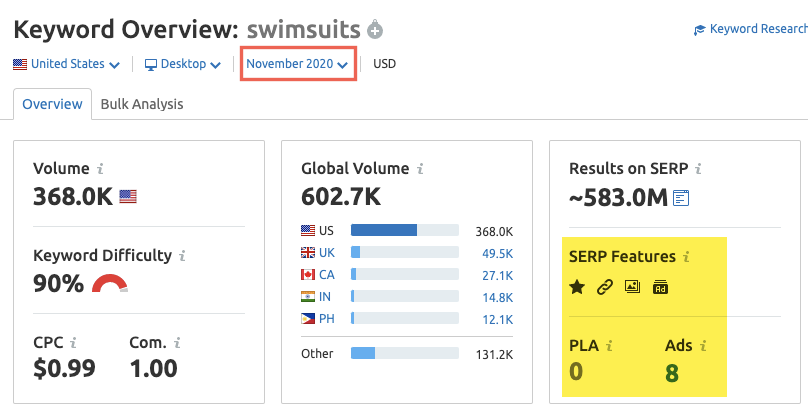
SEMRush
During off-peak season (November), the SERP for “swimsuits” includes:
- 8 PPC ads (top)
- Ratings / Reviews
- Sitelinks
- Images
- PPC ads (bottom)
Much like the “winter coats” SERP, the “swimsuits” off-peak SERP is bare compared to the full SERP we see during “swimsuits” peak season.
Now the question is, how do we optimize for the enhanced SERP features available during peak season? First let’s identify which enhanced SERP features we have the ability to optimize for.
Here’s the list of enhanced SERP features during peak season (June for “swimsuits”:
- 8 PPC ads (top) – PPC, not applicable
- 10 Product listing ads – PPC, not applicable
- Local Map pack – can optimize for!
- Ratings / Reviews – can optimize for!
- Sitelinks – can “influence”!
- Top stories – can optimize for!
- Shopping ads – PPC, not applicable
- PPC ads (bottom) – PPC, not applicable
In the above list, we can optimize (or influence) for the following enhanced SERP features:
- Local Map Pack
- Ratings / Reviews
- Sitelinks
- Top stories
Optimizing for Enhanced SERP Features
This is all great, but how do you optimize for these enhanced SERP features? Let’s start at the top with the Local Map Pack. As you may have guessed, optimizing for Local Map Packs falls into the remit of Local SEO. So let’s dive in.
First, what is a Local Map Pack? When a user searches for a query that the search engine believes has local intent, Google will provide physical local businesses in the user’s area via Google Map Pack in the SERP (as shown below).
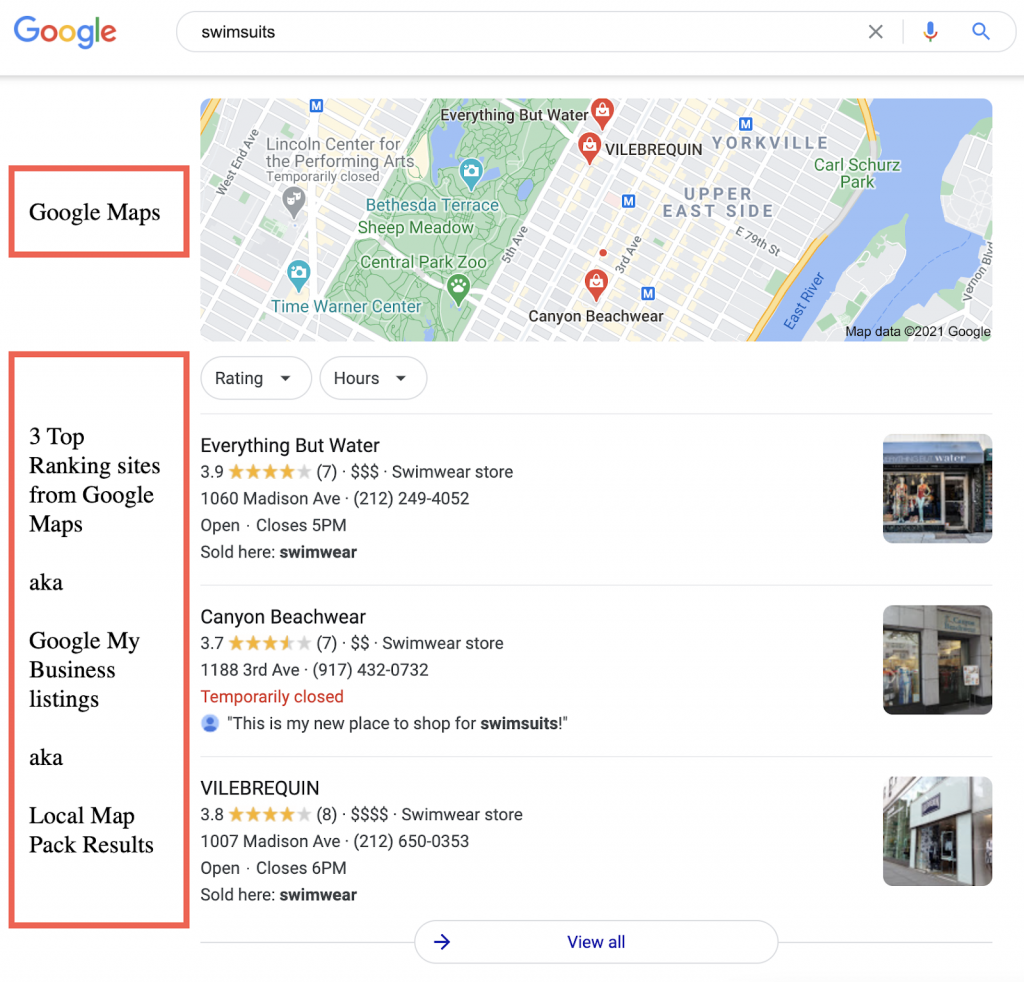
Typically, only three businesses will get the coveted positions in the Local Map Pack, which tend to have a much higher click through rate than other results on the SERP.
Now, how do we optimize for these crucial local results? There are two main ways to do this. The most important step is to create a Google My Business profile. This allows your business to tell Google the most important information for users interested in visiting your location like the name of your business, address, phone number (these three big ones are referred to as NAP – name, address, phone), hours of operation, ratings and reviews, etc. As you can imagine, this information is very powerful to help users quickly move through the purchase journey and convert and therefore Google loves using it. This just scratches the surface on how to optimize for Google Local Packs. For more detailed information, check out Google’s guidelines on optimizing for Local Packs.
The second step is to create and maintain your “citations” elsewhere on the web. For example, on other search engines like Bing, Yahoo, Apple Maps and on social media sites like Facebook, Twitter, and LinkedIn, and even online review sites like Yelp or TripAdvisor. These additional business citations in other reputable places sends signals to Google that your business is legitimate and helps cement the authority of your business in its eyes.
On to the second enhanced SERP feature, ratings and reviews. Of course this is super important because users trust other users’ opinions, especially when there are a lot of them. This can be implemented fairly easily once you ensure that product / services ratings & reviews can be crawled by search engines by adding them into the HTML on the relevant product / service pages.
From there, you can use schema markup, which is code (semantic vocabulary) that you add to your site to help search engines better understand its context and return more informative results for users on SERPs. Google provides documentation for both Review Schema markup as well as Aggregate Rating markup (the average rating based on multiple ratings or reviews). Make sure once it is implemented to validate it using Google’s Rich Results tool.
Moving on to the third enhanced SERP feature in our list, sitelinks. Sitelinks are links to other pages that can appear under SERP results and contain up to six links to other pages under the primary page result:
1. Brand keyword example
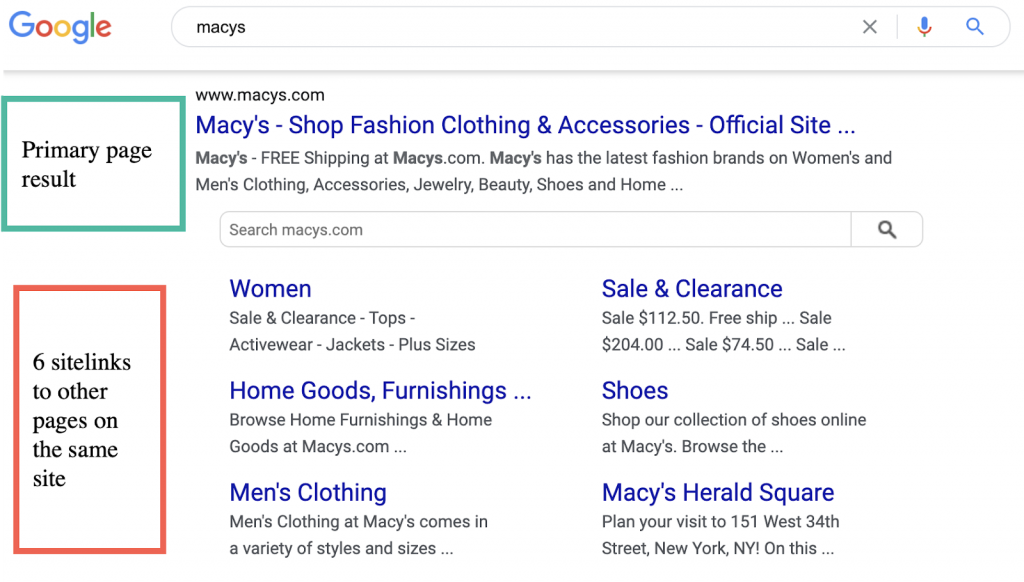
2. Nonbrand keyword example

Unfortunately, you can’t directly optimize for sitelinks; they are algorithmically generated. It was possible in the past to demote them in Google Search Console, but this alas is no longer an option. However, the most effective ways to influence their appearance lie in how your site is structured and connected:
- A deeper site structure (site architecture)
- Internal linking and usage of optimized anchor text
Ultimately, Google will show sitelinks if it thinks it is relevant to the user’s query and will expedite their conversion journey.
Last but not least, optimizing for the Top Stories carousel enhanced SERP feature. There are several prerequisites to showing up in the Top Stories carousel. The major ones are AMP support (fast page speed), Google News support, and using schema markup. Google News, while not required, but highly recommended, is a news aggregator that gathers news articles from a list of verified sites and serves articles to users based on their queries. There are several different qualifications needed if you want to be accepted into Google News and eligible for the Top Stories enhanced SERP feature. For more information on how to be accepted into Google News, check out Google’s documentation.
Summary
So what can you do to capitalize on the seasonality and make sure you stand out amongst the competition when the SERPs change for peak season?
First, check:
- If your site has traffic seasonality, and if so when?
This can help you determine when to push marketing campaigns or when you have “down time” and can do development work / site maintenance - If it does have traffic seasonality, check which keywords drive the majority of traffic and determine if those keywords have seasonality
Also, check your target business keywords for seasonality. You might not see any spikes in traffic from these keywords during your peak season if they are not ranking well enough to drive any substantial traffic to your site - Based on the above steps, you can now outline a plan that has your site capitalizing on seasonality during its peak season and taking advantage of off-peak season for any site changes or updates
Like any marketers, SEOs need to be aware of the ever-changing marketing landscape to get an edge on the competition. Seasonality is just one example where businesses can capitalize on the ebb and flow of consumer interest by developing an SEO strategy around their site’s peak season and ensuring it is optimized for its target business keywords. Check those SERPs often to stay ahead of the competition and to future proof for how Google will inevitably change them. Because whether or not its peak season, Google is always testing, adapting, and evolving its SERPs for the best user experience.

